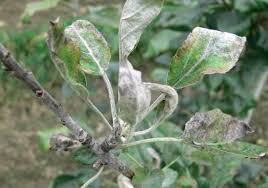Diseases of apple trees and their treatment
Fruit trees are susceptible to disease and the apple tree is no exception. And if you are a responsible gardener, look after your garden and want to get a decent harvest, then you should know about diseases of apple trees and methods of their treatment. The article will help you successfully diagnose the most dangerous of them and tell you how to proceed in each specific case.
Content
Powdery mildew
Causative agent powdery mildew - a dangerous parasite powdery mildew. The pest develops in the spring and affects the buds, leaves, shoots and bark of both young and adult apple trees. The main reason that contributes to the development and spread of the disease is excessive moisture in the soil and air.
A powdery coating of gray or off-white color is formed on the leaves, shoots and sometimes on the fruits. Over time, this plaque turns brown and multiple black blotches appear. Plaque can be easily removed in the initial stage, but over time it becomes denser. Under its action, the foliage begins to curl, turn yellow, gradually dry out, and the young leaves stop in their development. If the ovaries have managed to form, then they can crumble. The disease leads to a decrease in yield, in severe cases - up to 50%. Even low ambient temperatures in winter do not affect the causative agent of the disease. It overwinters calmly in the buds of infected shoots. Even in the harshest and coldest winters, the mycelium only slightly decreases, but still remains viable. The fungus is able to reduce the winter hardiness of the apple tree.
In autumn and spring, remove and be sure to burn shoots affected by powdery mildew. Use agrotechnical measures that can prevent excessive soil moisture.
In the prevention of this disease, the fungicide "Topaz" is successfully used. It is advisable to process the entire garden, especially if the varieties Semerenko, Boyken, White Rosemary are present. To suppress the primary infection, treatment with this drug begins at the beginning of the growing season. Usually, 4 spraying is carried out per season.
Once the crop has been harvested, the treatment continues by spraying with 1% Bordeaux liquid. A solution of copper sulfate is also perfect for this procedure. To prepare in a bucket of water, add 2 tbsp. spoons of copper sulfate and 1 tbsp. spoon of liquid soap.
Also use colloidal sulfur solution to control the pathogen for spraying. It is recommended to use it at least 3 times. The first is when the buds start to come out. The second - after the flowering phase and the third - 2 weeks after the second spraying.
Be aware that the fight against powdery mildew is quite protracted - the mushroom is very insidious and often gives relapses.
Video "Prevention and treatment of powdery mildew on apple trees"
This video will show you how to prevent and treat an apple tree suffering from such a common fungal parasite as powdery mildew.
Apple fungus - scab
This fungus mainly affects apple and pear trees. The disease is spread by spores with the help of water droplets. The ideal conditions for distribution are a rainy, lingering spring.
The main signs of the disease are olive-brown bloom on the leaves. Later, dark gray spots and many cracks appear on the fruit. It is through them that all kinds of infection can penetrate, which will cause rotting of the fetus.Since the fungus infects the leaf petioles, after a while they crumble, but the parasite does not destroy the development mechanism - photosynthesis and the infected tree continues to grow, which is what the fungus uses.
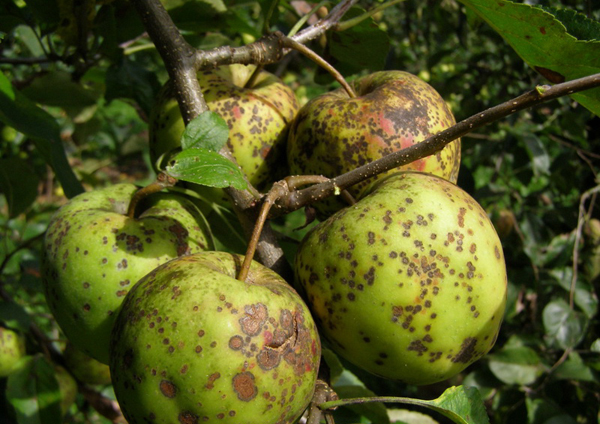
The fight against diseases of apple trees, including scab, first of all begins with preventive measures in the fall - harvesting foliage, dried fruits and branches. In the spring, before flowering, it is advisable to use the biofungicide "Fitosporin M" or Bordeaux liquid.
To combat scab use fungicides "Gamair", "Horus", "Fitolavin". Spraying is carried out both before flowering and after.
Mineral fertilizers have proven themselves well against the fungus, and this method can also be foliar feeding at the same time. For treatment, solutions of 15% potassium salt, 10% ammonium nitrate, 15% potassium nitrate, 10% high concentration ammonium sulfate are used. They can also be used for preventive maintenance, but in this case the concentration must be reduced.
Fruit rot or moniliosis
This disease traditionally manifests itself during fruit ripening, at the end of August. Especially if the weather is humid. If apple tree affected by scab or a moth, then this will be enough for moniliosis to develop: rot develops on a fruit infected with a fungus and, with the help of contacts, spreads to healthy fruits (an example of infection in the photo).
First, a small speck appears on the apple, which progresses very quickly and occupies the entire surface of the fruit. The apple acquires a brown color and becomes very soft. Such an apple should not be eaten. Moniliosis is much more insidious than powdery mildew or scab, as the symptoms do not appear immediately, but gradually. It is also dangerous after harvest - the infection can easily spread to healthy fruits through contact.
The onset of cold weather calmly transfers rot on sick, mummified fruits.

First of all, as soon as you notice a diseased affected fruit, immediately remove it from the tree. Do not forget about the carrion, it should be collected and buried. Do not leave mummified fruits for the winter, they also need to be disposed of. After you harvest, the places on the crown where the main foci of rot were located should be sprayed with a 5% urea solution.
Do not let the moth, sawfly, geese spread in the garden. These pests contribute to the development of moniliosis. Perform preventive spring spraying with a 0.3% solution of a suspension of copper oxychloride or 1% Bordeaux liquid. The first spraying is during the ripening of the buds, the second is immediately after flowering and the third is 2 weeks after the growing season.
To combat rot, use the drug "Hom". The drug is diluted in cold water according to the instructions and two sprays are carried out: during the appearance of new foliage and after flowering.
Remember that the key to effectively combating this ailment is not periodic, but regular spraying and constant maintenance of the garden.
Cytosporosis - a disease of the cortex
This parasitic fungus attacks the bark of the apple tree. The main reason for the development is non-compliance with the irrigation regime, as well as heavy or poor soil. Weak specimens or those that have damage to the integrity of the bark are mainly affected.
The main symptom of the lesion is the appearance of dark ulcers on the branches and trunk. Ulcers progress over time, become deeper and affect an ever larger area of the cortex. The bark, and then the affected branches, begin to die and fall off. If you do not provide prompt assistance, a sick specimen, as a rule, does not survive.
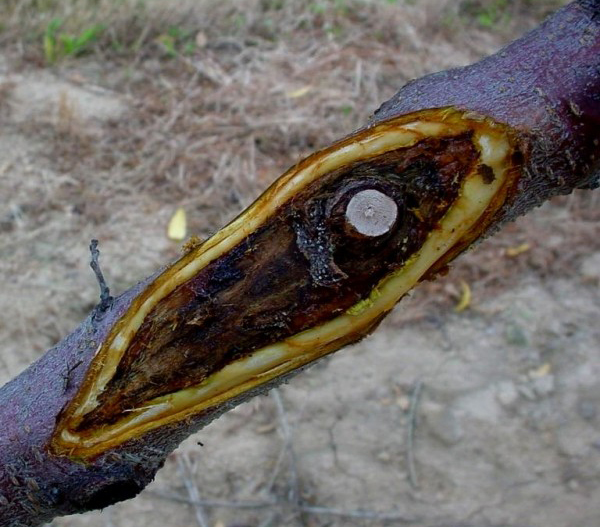
Make sure that there is no mechanical damage to the bark. After pruning, treat the wounds with clean linseed oil or garden varnish.
Successful treatment of cytosporosis can be achieved if it is started at the early stages of development, until the wood and cambium have suffered from the deep penetration of the fungus.
First, spraying with the "Hom" preparation is carried out. It is advisable to do this as soon as the kidneys begin to swell. Solution: dilute 40 g of the drug in 10 liters of cold water.
Then use copper sulfate. To prepare it, you need to dilute 50 g of the drug in 10 liters of cold water. The resulting solution is used to treat the garden until flowering. After flowering, it should be treated with Hom again.
Be sure to feed with potash and phosphorus-containing fertilizers on the eve of the winter cold.
Bacterial burn (bacteriosis)
The causative agent of the disease is the bacteria gram-negative bacilli. They are capable of infecting not only young, but also mature fruit-bearing trees. Bacteriosis spreads from top to bottom. Basically, this disease penetrates into the garden with newly acquired cuttings or young seedlings. The main factors of development are high ambient temperatures and warm rains. In most cases, fire blight is the main reason the apple tree loses its flowers.
The main signs of a fire blight are the presence of black spots on the entire fruit tree. If branches and shoots are affected, they become covered with dark watery spots. Affected foliage has a charred, burnt appearance. Over time, it will begin to bend specifically. But, despite its unviability, it does not fall off, but keeps on the branches.
If a fire blight affects the flowers, they change their color from white to dark brown and fall off the tree. In the event that the fruits suffer, they also become an unhealthy dark color, stop growing, but remain on the branches until late autumn.
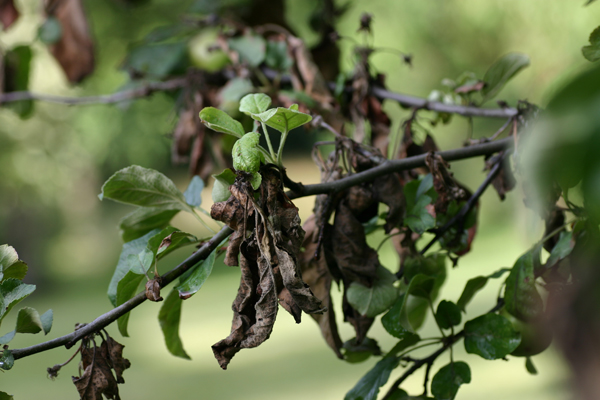
When buying a new seedling, carefully inspect all planting material so that it is healthy. Timely destroy all kinds of small pests-parasites in the garden. Indeed, many of them freely spread the disease throughout the garden. Disinfect the soil with copper sulfate (60 g sulfate per bucket of cold water).
Thanks to preventive measures, you can successfully fight this disease. Use agronomic techniques in the fight. First, remove (trim) the affected branches. It is better to carry out the procedure in late autumn or with the onset of winter. The cut should be 20 cm below the necrosis. Be sure to disinfect the tool that you will use, do not forget to do this with the saw cut. Sick branches cut down must be burned without fail. To increase the general immunity of the plant, carry out repeated spraying with Bordeaux liquid. It is advisable to do this at the very beginning of the vegetative process. These activities will help increase resistance to all kinds of fungal diseases.
Milky shine
The disease affects leaves and twigs. The causative agent is a basidiomycete. An infected tree will slowly die if not taken care of.
The main symptom is that the affected area becomes milky, silvery in color with a characteristic pearlescent sheen. Sick branches with a milky sheen cease to bear fruit. Fruits develop poorly, crumble, and after a few seasons the branches will dry out and die off. This disease manifests itself at the height of summer, in mid-July. It begins with the defeat of several branches, but quickly spreads along the trunk and leads to the nonviability of the skeletal branches, and sometimes it can lead to the death of the entire apple tree.
The main reasons contributing to the appearance and development of the disease are a lack of minerals in leaves and new shoots, improper watering, freezing of the bark. It is not worth planting seedlings on wet, low-lying land plots.
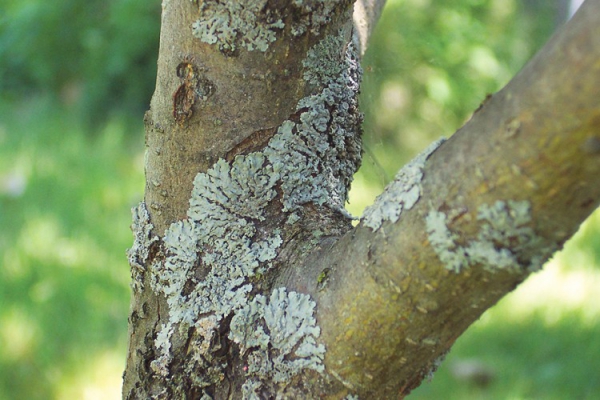
First of all, preventive actions are aimed at increasing the winter hardiness of the apple tree. Timely fertilization is carried out. Sick branches must be cut off and must be burned. When cutting, the cut is made 5 cm below the change (browning) of the wood. The resulting sections are disinfected with 1% copper sulfate.On the day of trimming, the wound must be covered with oil paint or garden varnish.
If there are badly damaged and shrinking apple trees in your garden, they must be dug up and burned.
Helps with diseases of the bark of apple trees whitewash skeletal branches and boles, which is carried out twice a season - at the end of winter and in autumn. To do this, use 20% milk of lime (dilute 2 kg of milk of lime for 10 liters of water). 500 g of 5% copper sulfate are added to the prepared mixture.
If you are the owner of a large garden and the trees in it are very dense, then the site is treated with a 2% solution of milk of lime using hose sprayers.
In dry and hot summers, make sure that watering is regular and sufficient. Do not forget to apply sufficient amounts of potash and phosphorus fertilizers. Monitor the condition of the soil, apply liming and drainage.
Perhaps this material will help you in the fight against diseases of apple trees. After all, timely, and most importantly, qualified assistance can save your green fruit plantations. The gardener must know the diseases and treatment of apple trees, otherwise he risks being left not only without a crop, but also without his garden.

